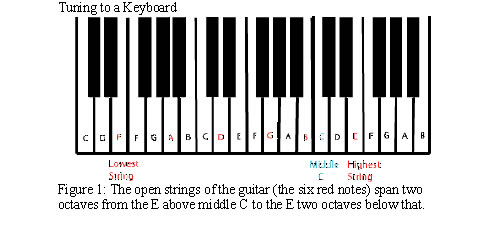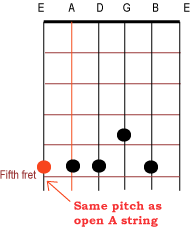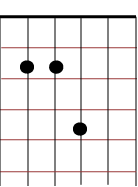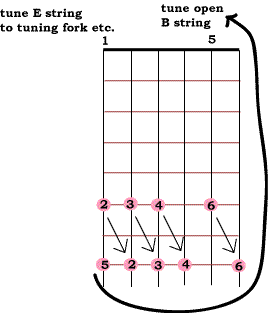|
Tuning Your GuitarLooking for a detailed description of different methods on Tuning Your Guitar? Look no further.. Get it here! By: Catherine Schmidt-Jones Summary: Different methods of guitar tuning give slightly different results. Your preferred method will depend both on what is easy and convenient for you and on what you want the result to sound like. IntroductionFor the beginning guitarist who is just practicing alone, it is most important to choose a guitar tuning method that is easy and convenient. But as you start to play with other people or become more picky about how your guitar sounds, the results of the different tuning methods will be more important to you. PitchpipesThere are pitchpipes available (check your local guitar supplier) that give the pitches for all six strings; you simply match the pitch of each string to the appropriate pipe. Pitchpipes are inexpensive (say, compared to an electronic tuner) and easy to use even for young beginners. They are small and easy to bring along. Pitchpipes do not have as clear and precise a pitch as a tuning fork, piano, or electronic tuner, and their pitches are equal temperament. (See the discussion in the keyboard section, below, for more about guitars and equal temperament.) The result is usually dissatisfying for more advanced players. Electronic TunerElectronic tuners have a more precise pitch than a pitchpipe and some people find the feature that lets them check their pitch useful when tuning your guitar. Some are large, but plenty are small and easy to bring along. Electronic tuners are quite expensive, however, and require batteries or an electrical outlet. Also, they are set to give equal temperament tuning (see the discussion below) and some people have trouble tuning to a thin, electronic tone. KeyboardIf an electronic keyboard or a well-tuned piano is available, this can also be an easy way of tuning your guitar. Be aware that guitar music actually sounds one octave lower than written, so the highest guitar string, for example, is only the E above middle C, not the E an octave and a third above middle C, as it is written. Obviously, this method of tuning your guitar is not useful when a keyboard is not available. But there is also the issue of exactly how you want your guitar to be tuned. Keyboards use equal temperament, which is basically the official tuning system of modern Western music. This system for tuning your guitar became so popluar and widely used, in fact, because it is so good for keyboard instruments; it is designed so that an instrument that uses it will play equally in tune no matter what key it plays in. This is very important for instruments like pianos and harps which cannot retune easily or quickly. There is a trade-off, though. In order for equal temperament to work, the only interval that is true to natural harmonics is the octave. All other intervals are a little off from the pure intervals found in the harmonic series (in other words, in nature, in the physics of sounds). For example, a perfect fifth in equal temperament is just a little smaller than a pure perfect fifth. Because piano is such a popular instrument, most listeners are comfortable with equal temperament. And yet, there is the fact that the intervals are not exactly "in tune". Musicians who can make small tuning adjustments very quickly ( vocalists, woodwind and brass players, and even players of unfretted strings, like the violin), often find themselves abandoning equal temperament when they can, and adopting the pure thirds and fifths of just intonation. You cannot tune a guitar instantly, as you can a voice, or even a (non-open-string) note on the violin. But you can tune a guitar relatively quickly; say in between songs. And guitar players rarely need or want to play equally in tune in all keys. Most guitar music favors easy-to-play keys, like E minor or D major, and avoids keys that require lots of bar chords, like A flat major or C sharp minor. So most guitarists do not use equal temperament tuning. Tuning You Guitar with a Tuning forkTuning forks that sound the popular tuning note "A" (which can be used to tune the fifth string) are very easy to find; tuning forks that sound an "E" (which can be used to tune the first and sixth strings) are also pretty easy to find and are more useful for guitars. A tuning fork is inexpensive and can easily be brought along. Another advantage is that if you touch it to the sounding board of an acoustic guitar, you will get a sound similar in color to the sound of that guitar being played. This can make using a tuning fork easier and more accurate than tuning your guitar to a sound that is a very different color (like a pitchpipe or electronic tuner). Many guitarists prefer to use a tuning fork. Tuning Your Guitar Using A Tuning Fork 1. Hold the fork by the stem only, leaving the tines free to vibrate. 2. Rap the tines once against something that is hard enough to start them vibrating. (But try not to rap them on something that they will dent or mark; your knee is a good choice.) 3. Immediately (but without touching the tines) set the stem lightly on the body of the guitar. Tune the string to the sound the guitar makes. Using a tuning fork well requires a little practice and is slightly cumbersome. It may be difficult for young players, and even experienced players won't want to bring along five or six different tuning forks. This brings us to the preferred methods for tuning guitars. Tuning Your Guitar by IntervalsThe advantage of this method of tuning your guitar is that the pure intervals give the guitar a very pleasing, resonant, in-tune sound on chords that have plenty of open strings, like E minor and G major. Tuning strings to other strings is also pretty easy once you've practiced a little. The disadvantage is that, since you are not using equal temperament, some chords are going to sound more in tune than others. Experienced guitarists simply tweak the tuning by ear as they change keys (for example, one might adjust the third string to give a better E major chord when playing in A major or E major). You may also find that your guitar sounds slightly out of tune when playing with a piano. 1. Tune the 6th string (the low E string), using a tuning fork, keyboard, piano, pitchpipe, or whatever is handy. Figure 3: Check your tuning by playing a chord of E's and B's. Listen carefully to see that all the octaves are in tune with each other, and that the fourth/fifth intervals between the E's and B's also sound good. Retune if necessary. Many experienced guitarists become so comfortable with hearing the pure fourths and third that they can tune simply by listening to the interval between the strings, rather than using the fifth-fret/open string unisons. Tuning Your Guitar by HarmonicsSome advanced guitarists prefer to tune using string harmonics, which cut out some of the string overtones, leaving a clear, easy-to-hear pitch. This is a little tricky to learn, but it gives a very accurate, resonant, pure-interval-based tuning. Because it is very easy to hear the pitch of the high, clear string harmonics, this tuning method gives a very accurate, pleasing tuning that takes advantage of pure intervals (fourths) to give the instrument a more resonant, vibrant sound (because pure intervals support and resonate with each other better). Note: For those interested in tuning theory: As far as I can tell, this tuning, based on a series of pure fourths, is not an official tuning system like Pythagorean tuning, which is based on a series of pure fifths. Like the Pythagorean system, though, if all the intervals were in fact pure, the result would not add up to pure octaves between the two E strings. I believe that most of the (slight) "fudging" necessary takes place around the B string, which is tuned with the third rather than the fourth. Harmonics are played by touching the string very lightly at the fret, rather than holding it down just below the fret. You must be comfortable with playing harmonics to use this method of tuning your guitar; it is not recommended for beginners.
Tuning you Guitar to D TuningD tuning in guitars refers to tuning the lowest string to D instead of E. This gives an extra resonant sound for playing in the key of D. Tune the guitar as usual, then retune the lowest string using the open 4th string D. (Tune the 6th string to an octave below the 4th string.) Check your tuning using a chord of D's and A's. 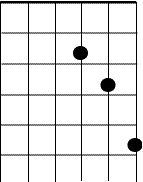
|




